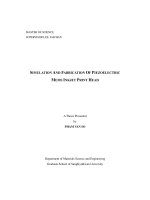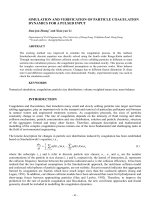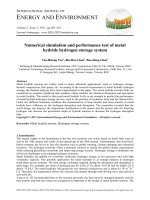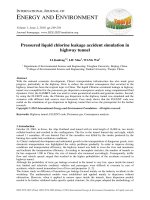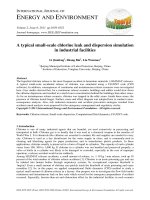Solidworks simulation
Bạn đang xem bản rút gọn của tài liệu. Xem và tải ngay bản đầy đủ của tài liệu tại đây (5.64 MB, 45 trang )
Engineering Analysis with
SolidWorks Simulation 2011
Paul M. Kurowski, Ph.D., P.Eng.
SDC
PUBLICATIONS
www.SDCpublications.com
Schroff Development Corporation
Design Generator, Inc.
Visit the following websites to learn more about this book:
Engineering Analysis with SolidWorks Simulation 2011
2: Static analysis of a plate
Topics covered
Using the SolidWorks Simulation interface
Linear static analysis with solid elements
Controlling discretization error with the convergence process
Finding reaction forces
Presenting FEA results in a desired format
Project description
A steel plate is supported and loaded, as shown in Figure 2-1. We assume that
the support is rigid (this is also called built-in support, fixed support or fixed
restraint) and that a 100000N tensile load is uniformly distributed along the
end face, opposite to the supported face.
Fixed restraint
100000N tensile load
uniformly distributed
Figure 2-1: SolidWorks model of a rectangular plate with a hole
We will perform a displacement and stress analysis using meshes with
different element sizes. Note that repetitive analysis with different meshes
does not represent standard practice in FEA. The process does however
produce results which are useful in gaining more insight into how FEA works.
31
Engineering Analysis with SolidWorks Simulation 2011
Procedure
In SolidWorks, open the model file called HOLLOW PLATE. Verify that
SolidWorks Simulation is selected in the Add-Ins list (Figure 2-2).
Simulation is now added to
the main SolidWorks menu.
Select Simulation as
an active Add-in and
Start up Add-in
Figure 2-2: Add-Ins list and SolidWorks SimulationManager tab
Verify that SolidWorks Simulation is selected in the list of Add-Ins (bottom).
Once Solid Works Simulation has been added, Simulation shows in the main
SolidWorks tool menu (top).
32
Engineering Analysis with SolidWorks Simulation 2011
If the Simulation tab is not showing in the CommandManager, add it by
following the steps outlined in Figure 2-3.
(1)
Right-click any tab in
the CommandManager
(2)
Check Simulation
Figure 2-3: How to display the Simulation tab in the SolidWorks CommandManager
Right-click any tab in the CommandManager and check “Simulation” from
the pop-up menu to make the Simulation tab visible.
33
Engineering Analysis with SolidWorks Simulation 2011
Before we create the FEA model, let’s review the Simulation main menu
(Figure 2-4) along with its Options window (Figure 2-5).
New study icon
Simulation Options
Figure 2-4: Simulation main menu
Simulation studies can be executed entirely for this menu. In this book we will
mainly use the main menu to access Simulation Options
34
Engineering Analysis with SolidWorks Simulation 2011
System Options tab
Default Options tab
SI system of units
Figure 2-5: Simulation Options window
The Options window has two tabs. Here, Default Options are shown.
Please spend time reviewing all of the options in both tabs shown in Figure
2-5 before proceeding with the exercise. In the Units options, make the
choices shown in Figure 2-5. In this book we will mostly use the SI system of
units, and occasionally switch to the IPS system.
Note that Default Plots can be added, deleted or grouped into sub-folders
which are created by right-clicking on the Static Study Results folder,
Thermal Study Results folder, etc.
35
Engineering Analysis with SolidWorks Simulation 2011
Creation of an FEA model starts with the definition of a study. To define a
new study, select New Study either from the Simulation menu (Figure 2-4)
or the Simulation CommandManager (Figure 2-6). Name the study tensile
load 01.
New study icon in the
Simulation CommandManager
You can also use it to
open the Study Advisor
Enter study name
Select Static
We’ll never use this option
except in chapter 18
Figure 2-6: Creating a new study
The study definition window offers choices for the types of analysis, here we
select Static.
36
Engineering Analysis with SolidWorks Simulation 2011
Once a new study has been created, all Simulation Commands can be invoked
in three ways:
From the Simulation main menu (Figure 2-4)
From the Simulation tab in CommandManager (Figure 2-6)
By right-clicking appropriate items in the study window
In this book, we will most often use the third method.
When a study is defined, Simulation creates a study located below the
SolidWorks FeatureManager window and places several folders in it. It also
adds a study tab that provides access to the study (Figure 2-7).
Simulation
Study
SolidWorks
model
Motion
study
Simulation
study
Figure 2-7: The Simulation window and Simulation tab
You can switch between the SolidWorks Model, Motion Studies and
Simulation Studies by selecting the appropriate the tab.
37
Engineering Analysis with SolidWorks Simulation 2011
We are now ready to define the analysis model. This process generally
consists of the following steps:
CAD geometry idealization and/or simplification in preparation for
analysis. This is usually done in SolidWorks by creating an analysis
specific configuration and making your changes there
Material properties assignment
Restraints application
Load application
38
Engineering Analysis with SolidWorks Simulation 2011
In this case, the geometry does not need any preparation because it is already
very simple, therefore we can start by assigning material properties.
Notice that if a material is defined for a SolidWorks part model, the material
definition is automatically transferred to the Simulation model. Assigning a
material to the SolidWorks model is actually a preferred modeling technique,
especially when working with an assembly consisting of parts with many
different materials. We will do this in later exercises.
To apply material to the Simulation model, right-click the HOLLOW PLATE
folder in the tensile load 01 simulation study and select Apply/Edit Material
from the pop-up menu (Figure 2-8).
Select Apply/Edit Material
to assign a material
Figure 2-8: Assigning material properties
39
Engineering Analysis with SolidWorks Simulation 2011
The action in Figure 2-8 opens the Material window shown in Figure 2-9.
Figure 2-9: Material window
Select Alloy Steel to be assigned to the model. Click Apply, then click Close.
40
Engineering Analysis with SolidWorks Simulation 2011
In the Material window, the properties are highlighted to indicate the
mandatory and optional properties. A red description (Elastic modulus,
Poisson’s ratio) indicates a property that is mandatory based on the active
study type and the material model. A blue description (Mass density, Tensile
strength, Compressive strength, Yield strength, Thermal expansion
coefficient) indicates optional properties. A black description (Thermal
conductivity, Specific heat, Material damping ratio) indicates properties not
applicable to the current study.
In the Material window, open the SolidWorks Materials menu, followed by
the Steel menu. Select Alloy Steel. Select SI units under the Properties tab
(other units could be used as well). Notice that the HOLLOW PLATE folder
in the tensile load 01 study now shows a check mark and the name of the
selected material to indicate that a material has been assigned. If needed, you
can define your own material by selecting Custom Defined material.
Defining a material consists of two steps:
Material selection (or material definition if a custom material is used)
Material assignment (either to all solids in the model, selected bodies of a
multi-body part, or to selected components of an assembly)
41
Engineering Analysis with SolidWorks Simulation 2011
Having assigned the material, we now move to defining the loads and
restraints. To display the pop-up menu that lists the options available for
defining restraints, right-click the Fixtures folder in the tensile load 01 study
(Figure 2-10).
Type tab
Split tab
This window shows
geometric entities where
fixtures are applied
Figure 2-10: Pop-up menu for the Fixtures folder and Fixture definition
window
All restraints definitions are done in the Type tab. The Split tab is used to
define a split face where a restraint is to be defined. The same can be done in
SolidWorks by defining a Split Line.
42
Engineering Analysis with SolidWorks Simulation 2011
Once the Fixtures definition window is open, select the Fixed Geometry
restraint type. Select the end-face entity where the restraint is applied.
Note that in SolidWorks Simulation, the term “Fixture” implies that the
model is firmly “fixed” to the ground. However, aside from Fixed Geometry,
which we have just used, all other types of fixtures restrain the model in
certain directions while allowing movements in other directions. Therefore,
the term “restraint” may better describe what happens when choices in the
Fixture window are made. In this book we will switch between the terms
“fixture” and “restraint” freely.
43
Engineering Analysis with SolidWorks Simulation 2011
Before proceeding, explore other types of restraints accessible through the
Fixture window. All types of restraints are divided into two groups:
Standard and Advanced. Review animated examples available in the
Fixture window and study the following chart.
Standard Fixtures
Fixed
Also called built-in, or rigid support. All translational and all
rotational degrees of freedom are restrained.
Immovable
Only translational degrees of freedom are constrained, while
rotational degrees of freedom remain unconstrained.
(No translations)
If solid elements are used (like in this exercise), Fixed and
Immovable restraints would have the same effect because
solid elements do not have rotational degrees of freedom.
Therefore, the Immovable restraint is not available if solid
elements are used alone.
Hinge
Applies only to cylindrical faces and specifies that the
cylindrical face can only rotate about its own axis. This
condition is identical to selecting the On cylindrical face
restraint type and setting the radial and axial components to
zero.
Advanced Fixtures
Symmetry
Applies symmetry boundary conditions to a flat face.
Translation in the direction normal to the face is restrained
and rotations about the axes aligned with the face are
restrained.
Roller/Sliding
Specifies that a planar face can move freely on its plane but
not in the direction normal to its plane. The face can shrink or
expand under loading.
Use reference
geometry
Restrains a face, edge, or vertex only in certain directions,
while leaving the other directions free to move. You can
specify the desired directions of restraint in relation to the
selected reference plane or reference axis.
On flat face
Provides restraints in selected directions, which are defined
by the three directions of the flat face where restraints are
being applied.
On cylindrical face
This option is similar to On flat face, except that the three
directions of a cylindrical face define the directions
of restraints.
On spherical face
Similar to On flat face and On cylindrical face. The three
directions of a spherical face define the directions
of the applied restraints.
Cyclic symmetry
Allows analysis of a model with circular patterns around an
axis by modeling a representative segment. The segment can
be a part or an assembly. The geometry, restraints, and
loading conditions must be identical for all other segments
making up the model. Turbine, fans, flywheels, and motor
rotors can usually be analyzed using cyclic symmetry.
44
Engineering Analysis with SolidWorks Simulation 2011
When a model is fully supported (as it is in our case), we say that the model
does not have any rigid body motions (the term “rigid body modes” is also
used), meaning it cannot move without experiencing deformation.
Note that the presence of restraints in the model is manifested by both the
restraint symbols (showing on the restrained face) and by the automatically
created icon, Fixture-1, in the Fixtures folder. The display of the restraint
symbols can be turned on and off by either:
Right-clicking the Fixtures folder and selecting Hide All or Show All in
the pop-up menu shown in Figure 2-10, or
Right-clicking the fixture icon and selecting Hide or Show from the popup menu.
Use the same method to control display of other symbols.
45
Engineering Analysis with SolidWorks Simulation 2011
Now define the load by right-clicking the External Loads folder and selecting
Force from the pop-up menu. This action opens the Force window as shown
in Figure 2-11.
This window shows
geometric entities where
loads are applied
Symbols settings
Figure 2-11: Pop-up menu for the External Loads folder and Force window
The Force window displays the selected face where the tensile force is applied.
If only one entity is selected, there is no distinction between Per Item and
Total. In this illustration, load symbols have been enlarged by adjusting the
Symbols Settings.
46
Engineering Analysis with SolidWorks Simulation 2011
In the Type tab, select Normal in order to load the model with a 100000N
tensile force uniformly distributed over the end face, as shown in Figure 2-11.
Check the Reverse direction option to apply a tensile load.
Generally, forces can be applied to faces, edges, and vertices using different
methods, which are reviewed below:
Force normal
Available for flat faces only, this option applies load in
the direction normal to the selected face.
Force selected direction
This option applies a force or a moment to a face,
edge, or vertex in the direction defined by the selected
reference geometry.
Moments can be applied only if shell elements are used.
Shell elements have six degrees of freedom per node:
three translations and three rotations, and can take a
moment load.
Solid elements only have three degrees of freedom
(translations) per node and, therefore, cannot take a
moment load directly.
If you need to apply moments to solid elements, they
must be represented with appropriately applied forces.
Torque
This option applies torque (expressed by traction
forces) about a reference axis using the right-hand rule.
Try using the click-inside technique to rename the Fixture-1 and
Force/Torque-1 icons. Note that renaming using the click-inside technique
works on all icons in SolidWorks Simulation.
The model is now ready for meshing. Before creating a mesh, let’s make a
few observations about defining the geometry, material properties, loads and
restraints.
Geometry preparation is a well-defined step with few uncertainties. Geometry
that is simplified for analysis can be compared with the original CAD model.
Material properties are most often selected from the material library and do
not account for local defects, surface conditions, etc. Therefore, the definition
of material properties usually has more uncertainties than geometry
preparation.
The definition of loads is done in a few quick menu selections, but involves
many assumptions. Factors such as load magnitude and distribution are often
only approximately known and must be assumed. Therefore, significant
idealization errors can be made when defining loads.
47
Engineering Analysis with SolidWorks Simulation 2011
Defining restraints is where severe errors are most often made. For example,
it is easy enough to apply a fixed restraint without giving too much thought to
the fact that a fixed restraint means a rigid support – a mathematical
abstraction. A common error is over-constraining the model, which results in
an overly stiff structure that underestimates displacements and stresses. The
relative level of uncertainties in defining geometry, material, loads, and
restraints is qualitatively shown in Figure 2-12.
Geometry
Material
Loads
Restraints
Figure 2-12: Qualitative comparison of uncertainty in defining geometry,
material properties, loads, and restraints
The level of uncertainty (or the risk of error) has no relation to time required
for each step, so the message in Figure 2-12 may be counterintuitive. In fact,
preparing CAD geometry for FEA may take hours, while applying restraints
and loads takes only a few clicks.
48
Engineering Analysis with SolidWorks Simulation 2011
In all of the examples presented in this book, we assume that definitions of
material properties, loads, and restraints represent an acceptable idealization
of real conditions. However, we need to point out that it is the responsibility
of the FEA user to determine if all those idealized assumptions made during
the creation of the mathematical model are indeed acceptable.
Before meshing the model, we need to verify under the Default Options tab,
in the Mesh properties, that High mesh quality is selected (Figure 2-13). The
Options window can be opened from the SolidWorks Simulation menu as
shown in Figure 2-4.
Mesh quality set to High
Mesh type set to Standard
Figure 2-13: Mesh settings in the Options window
Use this window to verify that the mesh quality is set to High and the mesh
type is set to Standard. Use these settings for other exercises unless indicated
otherwise.
49
Engineering Analysis with SolidWorks Simulation 2011
The difference between High and Draft mesh quality is:
Draft quality mesh uses first order elements
High quality mesh uses second order elements
Differences between first and second order elements were discussed in
chapter 1.
The difference between Curvature based mesh and Standard mesh will be
explained in chapter 3. Curvature based mesh is the default in Simulation.
However, Standard mesh will be used throughout this book because this
offers a better insight into mesh quality problems. This is done to enhance the
learning experience of the reader. Curvature based meshes will be used
rarely and will be pointed out.
Now, right-click the Mesh folder to display the pop-up menu (Figure 2-14).
Create Mesh
Figure 2-14: Mesh pop-up menu
In the pop-up menu, select Create Mesh. This opens the Mesh window
(Figure 2-15) which offers a choice of element size and element size tolerance.
This exercise reinforces the impact of mesh size on results. Therefore, we will
solve the same problem using three different meshes: coarse, medium
(default), and fine. Figure 2-15 shows the respective selection of meshing
parameters to create the three meshes.
50
Engineering Analysis with SolidWorks Simulation 2011
Figure 2-15: Three choices for mesh density from left to right: coarse,
medium (default), and fine
Select Mesh Parameters to see the element size. In all three cases use
Standard mesh. Note the different slider positions in the three windows. Verify
that standard mesh is used.
The medium mesh density, shown in the middle window in Figure 2-15, is the
default that SolidWorks Simulation proposes for meshing our model. The
element size of 5.72 mm and the element size tolerance of 0.286mm are
established automatically based on the geometric features of the SolidWorks
model. The 5.72 mm size is the characteristic element size in the mesh, as
explained in Figure 2-16. The default tolerance is 5% of the global element
size. If the distance between two nodes is smaller than this value, the nodes
are merged unless otherwise specified by contact conditions (contact
conditions are not present in this model).
Mesh density has a direct impact on the accuracy of results. The smaller the
elements, the lower the discretization error, but the meshing and solving time
both take longer. In the majority of analyses with SolidWorks Simulation, the
default mesh settings produce meshes that provide acceptable discretization
errors, while keeping solution times reasonably short.
51
Engineering Analysis with SolidWorks Simulation 2011
Figure 2-16: Characteristic element size for a tetrahedral element
The characteristic element size of a tetrahedral element is the diameter h of a
circumscribed sphere (left). This is easier to illustrate with the 2D analogy of
a circle circumscribed on a triangle (right).
Right-click the Mesh folder again and select Create… to open the Mesh
window.
With the Mesh window open, set the slider all the way to the left (as
illustrated in Figure 2-15, left) to create a coarse mesh, and click the green
checkmark button. The mesh will be displayed as shown in Figure 2-17.
Figure 2-17: A coarse mesh created with second order, solid tetrahedral
elements
You can control the mesh visibility by selecting Hide Mesh or Show Mesh
from the pop-up menu shown in Figure 2-14.
52
Engineering Analysis with SolidWorks Simulation 2011
The presence of a mesh is reflected in the appearance of the solid icon in a
Simulation study (Figure 2-18).
Before meshing
After meshing
Figure 2-18: Solid icon in a Simulation study before and after meshing
Cross hatching is added to the Solid icon in a Simulation study to show that a
mesh has been created.
To start the solution, right-click the tensile load 01 study folder which
displays a pop-up menu (Figure 2-19). Select Run to start the solution.
Figure 2-19: Pop-up menu for the tensile load 01 folder
Start the solution by right-clicking the tensile load 01 folder to display a popup menu. Select Run to start the solution.
The solution can be executed with different properties, which we will
investigate in later chapters. You can monitor the solution progress while
the solution is running (Figure 2-20).
53
